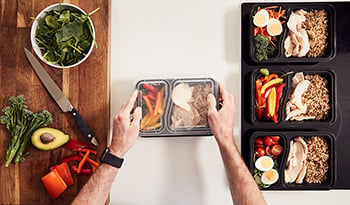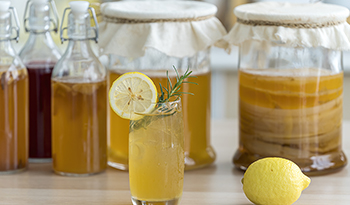Cum Să Mănânci Mai Sănătos: 7 Sfaturi Simple De La Un Dietetician

Puncte cheie
- Prioritizează proteinele și fibrele la fiecare masă pentru a crește sațietatea, ceea ce ajută la reducerea supraalimentării și a gustărilor.
- Echilibrați-vă farfuria folosind indicii vizuale de porție: o porție de proteine de dimensiunea palmei, o porție de carbohidrați de mărimea pumnului și cel puțin o ceașcă de fructe sau legume.
- Rămâneți bine hidratat, deoarece hidratarea adecvată poate reduce pofta de mâncare.
- Promovați consecvența și conștientizarea mâncând la fiecare 3-4 ore pentru a evita săritul meselor.
Ai nevoie de o resetare nutrițională?
Ai nevoie de o ajustare ocazională în multe domenii ale vieții pentru a menține lucrurile să funcționeze fără probleme. Vă întrețineți mașina în mod regulat pentru a evita problemele majore. Un check-in periodic cu un terapeut de masaj vă menține fără răni. Și același tip de reglare se poate face cu obiceiurile tale alimentare.
Nu există o singură modalitate corectă de a aborda nutriția. Dar o colecție de obiceiuri pozitive care se potrivesc stilului tău de viață te poate ajuta să progresezi spre obiectivele tale. Pierderea în greutate îmbunătățirea sănătății medicale, performanța sportivă și chiar un somn mai bun sunt câteva rezultate pe care le puteți observa atunci când vă modificați obiceiurile nutriționale.
Dacă doriți să vă îmbunătățiți obiceiurile nutriționale, ați ajuns la locul potrivit. Revizuirea întregii abordări a alimentelor poate fi descurajantă, dar fiți liniștiți știind că se pot adăuga mici modificări. Nicio pastilă magică nu poate îmbunătăți obiceiurile nutriționale pe care le-ați practicat de ani de zile, dar cu aceste sugestii, puteți face pași gestionabili pentru o alimentație mai bună.
7 sfaturi de nutriție susținute de știință
1. Tăie-ți zahărul în jumătate
Zahărul adăugat poate fi găsit într-o mare varietate de alimente - multe dintre ele s-ar putea să nu vă dați seama că conțin zahăr. În timp ce alimentele coapte, soda și bomboanele sunt surse evidente de zahăr adăugat, sosurile, pansamentele, condimentele și pâinea sunt surse mai puțin cunoscute de zahăr în dieta americană.
Cercetarile sugereaza ca zaharul adaugat poate creste riscul multor afectiuni de sanatate. Creșterea în greutate, hipertensiunea arterială, bolile hepatice grase și diabetul sunt câteva afecțiuni documentate asociate cu aportul ridicat de zahăr. În plus, fiecare dintre aceste afecțiuni crește riscul de atac de cord și accident vascular cerebral. Din aceste motive și multe altele, monitorizarea cantității de zahăr adăugat pe care o consumați este esențială.
Asociația Americană a Inimii recomandă nu mai mult de 150 de calorii de zahăr adăugat pe zi pentru bărbați și 100 de calorii pe zi pentru femei.
Dacă aportul actual de zahăr adăugat depășește aceste recomandări, există câteva modalități simple de a reduce zahărul adăugat în dieta ta. Îndulcitorii fără calorii, cum ar fi stevia, fructe de călugărși aluloza, sunt opțiuni excelente care oferă dulceață pentru puține calorii și fără zahăr adăugat. Fiecare dintre acestea poate fi folosit pentru a îndulci băuturile, cum ar fi cafeaua sau ceaiul, și poate fi folosit și la coacere și gătit.
De asemenea, puteți reduce aportul de zahăr consumând jumătate din produsele îndulcite cu care sunteți obișnuiți. Dacă mănânci două prăjituri în fiecare seară, țintește doar unul. Dacă folosești două linguri de zahăr în cafea în fiecare dimineață, încearcă să reduci la una.
2. Încărcați pe fibră
Fibrele sunt un nutrient care se găsește în alimentele pe bază de plante de toate tipurile. În timp ce fibrele au multe beneficii, unul dintre cele mai cunoscute este capacitatea sa de a crește sațietatea. Asta înseamnă că vă veți simți mai plin după o masă plină de fibre și mai puțin probabil să mâncați în exces și să gustați alimente mai puțin de calitate pe tot parcursul zilei.
Suplimentele de fibre sunt disponibile sub formă de capsule și gumă, care pot fi ușor încorporate în ziua ta. De asemenea, puteți adăuga forme sub formă de pudră la smoothie-ul preferat sau la un pahar cu apă pentru o modalitate rapidă de a vă crește aportul.
Suplimentele sunt foarte bune, dar alegerea alimentelor fibroase este o soluție și mai bună. Puteți crește fibrele din dieta dvs. consumând mai multe fructe, legume, cereale integrale, semințe și leguminoase. Cerealele integrale vin într-o mare varietate, inclusiv fulgi de ovăz, quinoași biscuiți, doar pentru a numi câteva opțiuni. Fructele uscate sunt un alt aliment ambalat în fibre care poate fi luat cu ușurință din mers pentru o gustare rapidă sau o adăugare de masă.
Fasolea și lintea sunt printre alimentele cu conținut ridicat de fibre. Pot fi încorporate perfect în salate, supe și mâncăruri laterale pentru mese bogate în fibre. În cele din urmă, nuci și semințe sunt o sursă convenabilă de fibre, deoarece pot fi consumate din mers sau adăugate la diverse mese și gustări pentru o sursă de fibre fără pregătire.
3. Mănâncă proteine la fiecare masă
La fel ca fibrele, proteina este un alt nutrient sățios care poate reduce supraalimentarea și excesul de gustări. Proteinele servesc ca un element de construcție pentru mușchi, oase, piele și chiar sânge, iar unele alimente bogate în proteine sunt, de asemenea, bogate în nutrienți importanți precum fierul și zincul.
Pentru a maximiza beneficiile pentru sănătatea musculară și sațietate, concentrați-vă pe distribuirea uniformă a aportului de proteine în mesele dvs., în loc să consumați cea mai mare parte a acestuia la cină. Răspândirea proteinelor ajută la stimularea continuă a sintezei proteinelor musculare, procesul prin care corpul tău construiește și repară țesutul muscular. Vizarea a aproximativ 20-40 de grame de proteine de înaltă calitate la fiecare masă principală este o strategie mai eficientă pentru menținerea și creșterea musculară decât un aport zilnic înclinat.
Alimentele vegetale și animale conțin proteine, astfel încât sursele de proteine sunt disponibile indiferent de preferințele dvs. dietetice. Nucile și semințeleși untul de nuci, sunt surse de proteine pe bază de plante care nu necesită pregătire, pot fi încorporate în mese și gustări și sunt perfecte atunci când ai nevoie de ceva din mers.
Peștele conservat și în pungi, inclusiv somonul și tonul, sunt o altă formă de proteine fără pregătire care poate fi savurată într-o varietate de moduri. Combinați cu piure de avocado și serviți peste biscuiți sau adăugați direct pe un pat de salată pentru o inspirație ușoară a mesei.
Dacă vă place să mâncați micul dejun pe fugă, pudra de proteine amestecată cu fructe este o opțiune ușoară și echilibrată.
4. Echilibrează-ți farfuria
Fiți atenți la porții: Când vă serviți mesele, asigurați-vă că porțiile dvs. sunt adecvate. Ca ghid, asigurați-vă că porția dvs. de proteine are aproximativ dimensiunea palmei, porția de carbohidrați nu este mai mare decât dimensiunea pumnului, iar farfuria sau bolul dvs. are cel puțin o ceașcă de fructe sau legume.
Încorporați o varietate de plante: Dincolo de a obține suficiente fructe și legume, încercați să mâncați o mare diversitate de alimente diferite pe bază de plante în fiecare săptămână. Fiecare plantă conține fibre unice și fitonutrienți care hrănesc diferite bacterii benefice din intestin. Un microbiom intestinal mai divers este puternic legat de o sănătate imună mai bună și de bunăstarea generală. Încercați să încorporați 30 sau mai multe tipuri diferite de plante pe săptămână, inclusiv legume, fructe, cereale integrale, nuci, semințe, leguminoase și ierburi.
5. Nu Sari De O Masă
Când te concentrezi pe îndeplinirea sarcinilor zilnice, să mergi prea mult fără să mănânci poate fi tentant. Și, deși poate părea că omiterea meselor și a gustărilor este o soluție pentru pierderea în greutate, acest lucru poate face mai dificilă atingerea obiectivelor. Consumul de porții adecvate de alimente de bună calitate pe tot parcursul zilei vă aduce beneficii obiectivelor de greutate și vă asigură că obțineți suficienți nutrienți pentru a susține nevoile organismului. Pentru a vă asigura că nu săriți peste mese, păstrați mâncarea stabilă la raft la îndemână pentru opțiuni rapide.
O bară proteică cu fructe proaspete, o porție de somon sau ton cu biscuiți și o mână de morcovi, sau un măr cu unt de nuci și o bucată de sacadat pe lateral sunt doar trei mese rapide care pot fi puse împreună în câteva secunde. Încercați să mâncați în decurs de o oră de la trezire și la fiecare trei până la patru ore pe parcursul zilei, terminând ultima mâncare cu cel puțin două ore înainte de a vă culca.
6. Rămâi bine hidratat
S-ar putea să fiți surprinși să aflați că hidratarea vă poate afecta obiceiurile alimentare. Când sunteți subhidratat, este posibil să doriți mai multe alimente amidonice și sărate care promovează stocarea apei în corpul dumneavoastră. Este posibil să observați mai puține pofte alimentare și o sațietate crescută atunci când sunteți bine hidratat.
Păstrarea unei sticle de apă reîncărcabile la îndemână este o soluție ușoară pentru a vă ajuta să beți mai multă apă. De asemenea, puteți număra alte băuturi fără cofeină și fără zahăr în aportul zilnic total de lichide. Ceaiul din plante și apa spumantă sunt surse excelente de hidratare. Puteți adăuga chiar și potențiatori de aromă în apă pentru a încuraja un consum mai mare de lichide.
7. Scrieți-l
Urmărirea a ceea ce mănânci și bei zilnic poate aduce beneficii și obiceiurilor tale generale de nutriție. Indiferent dacă utilizați o aplicație pentru a vă urmări aportul sau pentru a ține un jurnal alimentar pe o bucată de hârtie pe tot parcursul zilei, urmărirea vizuală vă poate ajuta să identificați zonele în care excelați sau locurile din dieta dvs. care s-ar putea îmbunătăți. În timp ce trackerele detaliate care calculează calorii și grame de nutrienți pot fi utile pentru unii, alții consideră că acest nivel de detaliu este copleșitor.
Vestea bună este că orice nivel de urmărire, indiferent dacă observați doar mâncarea și porția sau estimați fiecare nutrient din fiecare aliment, vă poate lumina despre obiceiurile dvs. zilnice. Această urmărire poate reduce, de asemenea, alimentația fără minte și vă poate ajuta să deveniți mai intenționați cu alegerile zilnice de mâncare și băutură.
Punerea în practică: un exemplu de zi de alimentație sănătoasă
- Mic dejun: Bol de ovăz cu iaurt grecesc cu fructe de pădure și nuci.
- Prânz: O salată mare cu pui la grătar, năut și un pansament pe bază de ulei de măsline.
- Gustare: Un măr cu unt de migdale.
- Cina: Somon copt cu broccoli prăjit și quinoa.
- Aportul de apă: 3,7 litri de apă pentru bărbați și 2,7 litri pentru femei
Întrebări frecvente despre obiceiurile alimentare
Care este cel mai important sfat nutrițional?
Cercetările revizuite de colegi și organizațiile majore de sănătate subliniază faptul că modelul alimentar general este cel mai important factor pentru sănătatea pe termen lung. În loc să vă concentrați pe un singur nutrient, cel mai important sfat este să adoptați un model alimentar echilibrat bogat în alimente întregi.
Aceasta implică consumul regulat de fructe și legume, cereale integrale, proteine slabe (cum ar fi pește, păsări de curte, fasole și nuci) și grăsimi sănătoase, limitând în același timp alimentele procesate, zaharurile adăugate și grăsimile saturate. Această abordare holistică are cele mai puternice dovezi pentru reducerea riscului de boli cronice.
Trebuie să număr calorii pentru a mânca sănătos?
Nu, nu trebuie să numărați calorii pentru a mânca o dietă sănătoasă. În timp ce numărarea caloriilor este un instrument pentru gestionarea greutății, cercetările arată că concentrarea asupra calității alimentelor și a alimentației conștiente poate fi o abordare mai durabilă și mai puțin restrictivă pentru sănătatea generală.
Strategii precum „mâncatul intuitiv” - care implică acordarea atenției la semnele naturale de foame și plenitudine ale corpului tău - s-au dovedit a fi eficiente pentru menținerea unei greutăți sănătoase și îmbunătățirea bunăstării psihologice. Prioritizarea alimentelor bogate în nutrienți, întregi duce adesea la controlul natural al porțiunilor și la rezultate mai bune pentru sănătate, fără a fi nevoie de urmărire strictă.
Care este cel mai simplu mod de a adăuga mai multe legume în dieta mea?
Cercetările privind schimbările comportamentale sugerează că cel mai „simplu” mod de a adăuga mai multe legume este de a le face mai convenabile și mai accesibile. Cu cât este nevoie de mai puțin efort, cu atât este mai probabil să le mâncați.
Acest lucru poate fi realizat prin strategii simple, cum ar fi „stivuirea obiceiurilor” - adăugarea de legume la mesele pe care le consumi deja (de exemplu, adăugarea de spanac la ouăle de dimineață sau o mână de verdeață într-un sos de paste). Alte metode dovedite includ tăierea în prealabil a legumelor (cum ar fi morcovii, castraveții și ardeii grași) și păstrarea lor la nivelul ochilor în frigider pentru gustări ușoare și încorporarea legumelor amestecate în smoothie-uri și supe.
Referințe:
- Editura Harvard Health. „Pericolul dulce al zahărului”. Harvard Health, 6 ianuarie 2022, www.health.harvard.edu/heart-health/the-dulce-danger-of-sugar.
- Asociația Americană a Inimii. „Zaharuri adăugate”. www.heart.org, Asociația Americană a Inimii, 2 noiembrie 2021, www.heart.org/en/healthy-living/healthy-eating/eat-smart/sugar/added-.
- -Departamentul Agriculturii al SUA. „Alimente proteice”. www.myplate.gov, 2020, www.myplate.gov/eat-healthy/protein-foods.
- Schoenfeld BJ, Aragon AA. Câte proteine poate folosi organismul într-o singură masă pentru construirea mușchilor? Implicații pentru distribuția zilnică a proteinelor. J Int Soc Sports Nutr. 2018 27 februarie; 15:10. doi: 10.1186/s12970-018-0215-1. PMID: 29497353; PMCID: PMC5828430.
- Smith RP, Easson C, Lyle SM, Kapoor R, Donnelly CP, Davidson EJ, Parikh E, Lopez JV, Tartar JL. Diversitatea microbiomului intestinal este asociată cu fiziologia somnului la om. PLoS One. 7 octombrie 2019; 14 (10): e0222394. doi: 10.1371/journal.pone.0222394. PMID: 31589627; PMCID: PMC6779243.
- Clinica Mayo. „Apa: cât ar trebui să bei în fiecare zi?” Clinica Mayo, 12 octombrie 2022, www.mayoclinic.org/healthy-lifestyle/nutrition-and-healthy-eating/in-depth/water/art-20044256.
- -Orientări dietetice pentru americani. „Orientări dietetice pentru americani, 2020-2025 și materiale online | Ghiduri dietetice pentru americani.” www.dietaryGuidelines.gov, decembrie 2020, www.dietaryguidines.gov/resources/2020-2025-dietary-guidines-online-materials.
- Braga-Pontes, Cátia și colab. „Strategii de educație nutrițională pentru promovarea consumului de legume la copiii preșcolari: Proiectul Veggies4myHeart”. Nutriție pentru sănătate publică, vol. 25, nr. 4, 27 octombrie 2021, pp. 1061—1070, iconline.ipleiria.pt/bitstream/10400.8/6647/1/nutriție-educație-strategii-promovare-consuma-legume-în-preșcolar-copii-veggies4myheart-project.pdf, https://doi.org/10.1017/s1368980021004456.
Declarație de declinare a responsabilității:Acest blog nu are ca scop să ofere un diagnostic.














































































 Cuprins
Cuprins
















